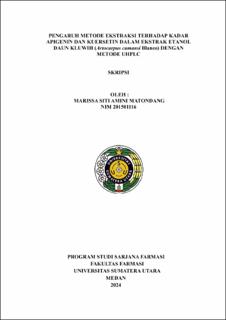| dc.description.abstract | Background: Kluwih leaves have benefits to cure for cirrhosis, diabetes,
hypertension, skin diseases, and can also be used as an inflammatory drug. The
kluwih plant are used as antimicrobial, antidiabetes mellitus, anticancer,
antimalarial, and for the treatt of dysentery. Apigenin and quercetin are derivatives
of flavonoids found in kluwih leaves.
Objectives: The purpose of the study was to compare the content of apigenin and
quersetin from four different extraction methods, as follow: maceration,
percolation, reflux, socletation using UHPLC method and to determine the method
and conditions of UHPLC used to meet the validation requirements.
Methods: Analysis by UHPLC method used mobile phase aquabidest: acetonitrile:
methanol (50 : 30 : 20) with flow rate of 0.5 ml/min, column temperature of 35℃
with wavelength of 350 nm, injection volume of 10 μl and C18 column.
Results: The results of the research with these UHPLC conditions have good
results. The chromatogram results of kluwih leaves extract showed that there were
apigenin and quercetin compounds. The apigenin content values of extracts
maceration, percolation, reflux, and socletation respectively are 0.0295 mg ±
0.0008; 0.1015 mg ± 0.0001; 0.0120 mg ± 0.0005; and 0.0685 mg ± 0.0009. The
highest apigenin content resulted from the percolation method of kluwih leaves
extract. The quercetin content values of extracts maceration, percolation, reflux,
and socletation respectively are 0.1218 mg ± 0.0006; 0.0887 mg ± 0.0002; 0.1339
mg ± 0.0005; and 0.0392 mg ± 0.0005. The highest quercetin content was produced
from the reflux method of kluwih leaves extract. In calibration, correlation
coefficient for apigenin was 0.9993, quercetin was 0.9999. The validation test
results %recovery apigenin 103.88%, quercetin 108.76%; %RSD apigenin 0.34%,
quercetin 0.51%; LOD apigenin 1.3645 ppm, quercetin 0.5547 ppm; LOQ apigenin
4.1347 ppm, quercetin 1.6810 ppm.
Conclusions: There is an effect of extraction method on the content of apigenin
and quercetin compounds in kluwih leaves. The method used for the examination
of apigenin and quercetin levels meets the requirements of the validation test. | en_US |


